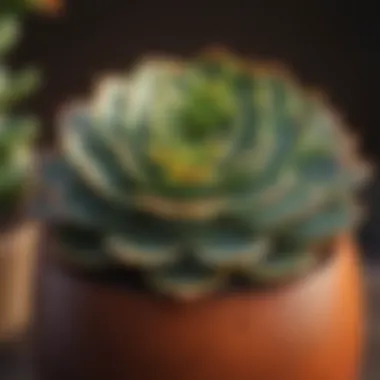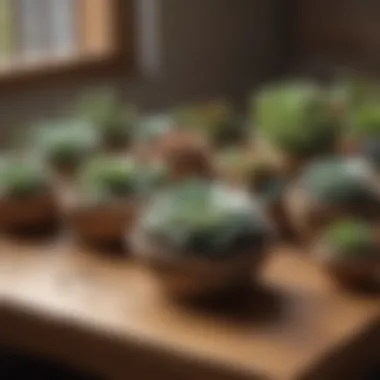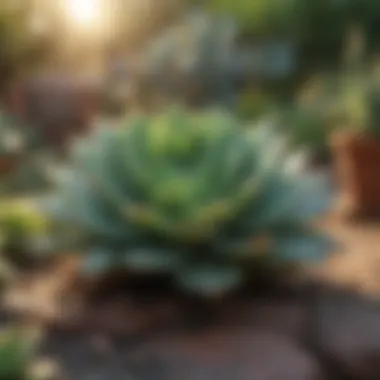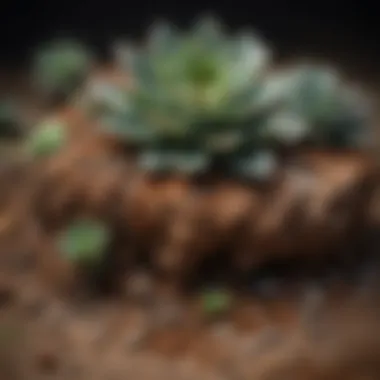Mastering the Art of Watering Succulents


Intro
Succulents are popular plants recognized for their unique resilience and adaptability. These plants thrive in a range of environments, making them suitable for both indoor and outdoor settings. Proper watering is essential for their health, as succulents possess distinctive characteristics that influence their hydration needs. In this article, we will explore the factors affecting the watering requirements of succulents. This includes their physiological traits, environmental conditions, and soil composition.
Understanding how to care for succulents not only enhances their aesthetic appeal but also ensures longevity. Various elements play crucial roles in this process. For instance, the climate in which they are kept can create different challenges. Additionally, not all soil types are suitable for their growth. Even the frequency of watering depends on several factors, from season to sunlight exposure.
As we move through the sections of this article, we will synthesize practical guidelines and highlight common mistakes made by many succulent enthusiasts. This aims to equip homeowners, gardening aficionados, and design enthusiasts with the knowledge they need for optimal succulent care.
Prologue to Succulents
Understanding succulents is fundamental for anyone interested in gardening or caring for plants. These unique species are a category of plants that store water in their leaves, stems, or roots. As such, they exhibit distinctive watering needs that differentiate them from other plants. Effective care of succulents involves recognizing these needs. This section serves as a gateway into the world of these remarkable plants.
Succulents are more than just aesthetically pleasing; they have gained popularity due to their resilience and minimal care requirements. However, this does not mean they are entirely carefree. To thrive, they require specific watering strategies. Misjudging their watering needs can lead to problems such as over-watering or under-watering. Hence, learning about succulents is an essential step for aspiring gardeners.
Definition of Succulents
Succulents refer to a group of plants that have thickened and fleshy parts. This structure allows them to retain water, making them well-suited for arid environments. The word "succulent" derives from the Latin word "sucus," meaning juice or sap. These plants possess various adaptations that enable them to survive with minimal water. They come in many shapes and sizes, each showcasing their unique characteristics.
Common Types of Succulents
Succulents can be categorized into various types based on their characteristics and habitats. Some of the most commonly known types include:
- Aloe Vera: Renowned for its medicinal properties, Aloe Vera is a popular indoor succulent.
- Echeveria: These rosette-shaped plants are favored for their ornamental appeal.
- Sedum: Known for their versatility, Sedums can thrive in poor soil conditions.
- Jade Plant (Crassula ovata): Often associated with good luck, Jade plants are robust succulents suitable for indoor environments.
- Haworthia: These small, often striped succulents are ideal for closed spaces, as they flourish with indirect sunlight.
In sum, succulents deserve attention for their unique beauty and vibrant adaptability. This section aims to provide foundational knowledge and set the stage for understanding their specific watering needs. This will be further explored in subsequent sections.
Watering Succulents: A Fundamental Guide
Understanding how to effectively water succulents is vital for anyone interested in keeping these plants healthy and vibrant. Succulents have adapted to store water in their leaves and stems, leading to unique watering needs compared to other plants. Over-watering or under-watering can quickly lead to detrimental effects. This section aims to explore essential concepts that will help readers care effectively for their succulents.
Understanding Water Needs
Succulents require less frequent watering than many other household plants. Their adaptations allow them to thrive in arid conditions, but this does not mean they do not need water. The amount of water a succulent needs can vary based on several factors, including species, climate, and the specific growing conditions. Generally, it is advisable to allow the soil to completely dry out between watering sessions. To determine when to water, observe the plant closely and consider its environment. For example, a succulent in a dry, hot climate may need more frequent watering than one in a cooler, humid area.
Signs of Under-Watering
Recognizing the signs of under-watering is crucial for maintaining healthy succulents. When a succulent does not receive enough water, it may show certain symptoms:
- Wrinkled Leaves: Succulents may appear shriveled or wrinkled.
- Dry, Crispy Tips: The tips of the leaves can become dry and brown, indicating a lack of moisture.
- Droopy Appearance: The entire plant may appear limp or weak.
An under-watered succulent can recover quickly when watered appropriately. It is important to resume a consistent watering schedule to rejuvenate the plant back to health.
Signs of Over-Watering
While under-watering is a risk, over-watering can be even more damaging. Overly moist conditions can lead to root rot and other issues. Signs of over-watering include:
- Yellowing Leaves: When leaves begin to turn yellow, it may signal excess moisture.
- Mushy or Soft Leaves: Healthy leaves should feel firm, while mushy leaves indicate decay.
- Foul Odors: A distinct smell from the soil can signal decomposition.
To prevent over-watering, ensure pots have adequate drainage and confirm that the top layer of soil dries out before watering again. Observing these signs will allow for prompt action to save the succulent.


Proper water management is essential for the vitality of succulents. Both under-watering and over-watering can have dramatic effects. Maintaining a balance is key.
Factors Influencing Water Requirements
Climate and Seasonal Changes
Climate directly affects the water needs of succulents. In a hot, dry environment, succulents lose water at a rapid rate through transpiration. During these times, more frequent watering may become necessary. Conversely, if you live in a cooler, humid area, succulents might thrive with less frequent watering. Seasonal changes introduce further variables. For instance, succulents often enter a dormant phase during the winter months, requiring significantly less water than in the summer. Homeowners should closely monitor local weather patterns and adjust their watering schedules accordingly.
Sunlight Exposure
Sunlight exposure is another critical factor. Succulents generally prefer bright light, but too much direct sunlight can lead to stress. Stress can increase a plant's need for water, particularly if the plant is wilting. Providing indirect sunlight or partial shade may help mitigate this issue, especially in extreme summer heat. Conversely, insufficient sunlight can weaken the plant, leading to over-watering as the owner attempts to compensate for other growth issues. It's important for plant owners to understand the balance of sunlight their specific succulent species requires to maintain appropriate water needs.
Soil Composition
Soil composition plays a pivotal role in water retention. A well-draining soil mix allows excess moisture to escape, preventing root rot, which can occur in soggy soil. Typically, a blend of potting soil and materials like perlite or sand can enhance drainage. The composition should facilitate the right balance between moisture retention and drainage. Different succulent types also have varying soil preferences. Recognizing these preferences can improve water management significantly, reducing the chance of over or under-watering.
Pot Size and Material
The size and material of a pot affect how quickly the soil dries out. Larger pots retain more moisture compared to smaller ones, which may necessitate less frequent watering. Additionally, the material of the pot matters. Terracotta pots are porous and allow moisture to evaporate more quickly. This characteristic makes them suitable for succulents that require drier conditions. On the other hand, plastic pots retain moisture better and are advisable for plants that can tolerate higher humidity levels. Choosing the right size and material is essential for successful succulent care.
Proper planning around these factors can ensure that your succulents thrive, not just survive.
By considering climate, sunlight, soil, and pot characteristics, homeowners can create an optimized environment for their succulents. Understanding these influences on watering needs reinforces the importance of careful observation and adaptation in plant care.
Watering Techniques for Succulents
Understanding the right watering techniques is crucial for successfully growing succulents. These plants store water in their leaves and stems, but only thrive with proper moisture management. Incorrect watering can lead to a range of problems, such as root rot or dehydration, which ultimately affects the plant's health. By familiarizing yourself with efficient watering techniques, you can help your succulents flourish in various environments.
Watering Frequency
Watering frequency varies significantly based on several factors, including climate, soil type, and the specific species of succulent. On average, succulents need water every two to three weeks during the growing season, which lasts from spring to early fall. During the dormant period, typically in winter, watering can be reduced to once every four to six weeks. However, it is essential to observe your plants. Factors such as dryness of the soil and environmental humidity should guide your schedule. Remember, it is better to underwater than overwater. A simple method to check if your succulent needs water is to poke your finger into the soil. If it feels dry an inch below the surface, it is time to water.
Best Practices for Watering
When watering succulents, adhering to certain best practices can significantly enhance their survival and growth. Firstly, always water at the soil level rather than soaking the leaves. This minimizes the risk of rot, as wet leaves can lead to fungal issues. Secondly, use the deep soak method. This allows water to reach the roots. Pour water until it drains out of the pot's holes, ensuring the entire root system receives moisture. During this process, ensure excess water does not sit in the tray beneath the pot, as this can encourage root rot. Lastly, adjust your watering schedule as needed when your succulents show signs of stress, such as shriveling leaves or color changes.
Tools for Effective Watering
Having the right tools can make watering your succulents much easier and more effective. A watering can with a narrow spout is advantageous for directing water precisely at the soil level. For smaller indoor plants, dropper bottles or syringes help control the amount of water applied. Additionally, moisture meters can assist in determining soil moisture, taking the guesswork out of when to water. Implementing these tools will simplify the watering process while ensuring the health of your succulents.
"Proper watering techniques transform the care of succulents from a daunting task into an almost effortless endeavor."
By mastering these techniques, succulents can become an enriching part of your indoor or outdoor plant collection. Tailoring your watering approach to suit both the plants' needs and the environmental conditions will promote vibrant and resilient growth.
Rescuing Over-Watered Succulents
Over-watering is a common problem for succulent enthusiasts. It can lead to serious health issues for the plants. Succulents are designed to store water, so too much moisture can be detrimental. Understanding how to rescue an over-watered succulent is crucial for maintaining plant health. This section dives into the signs of damage and deliberate actions you can take to restore your plants to their former glory.


Identifying Damage
To effectively rescue an over-watered succulent, you must first identify the signs of damage. Typically, symptoms manifest in a few distinct ways:
- Softened Leaves: Healthy succulent leaves should be firm and plump. When leaves become mushy or squishy, this signals that they have absorbed too much water.
- Discoloration: Check for browning or yellowing leaves. This color change can suggest root rot.
- Foul Smell: A rotting odor can indicate decayed roots. Succulents should smell fresh, not rancid.
- Wilting or Dropping Leaves: Over-watering can lead to leaf drop as the plant struggles to cope with excess moisture.
Understanding these signs will help you assess the extent of the damage and decide on further steps. Look at the overall condition of your plant. If multiple symptoms are present, immediate action is needed to prevent further decline.
Steps for Recovery
Once you've identified that your succulent has been over-watered, follow these critical steps for recovery:
- Remove Excess Water: If your succulent is in a pot with standing water, it is essential to remove it. Tilt the pot gently to drain any excess water.
- Examine the Roots: Carefully take the plant out of its pot. Inspect the roots for signs of rot. Healthy roots should be white and firm. If they are black or mushy, trim away the affected areas with clean scissors.
- Let it Dry: After pruning, allow the plant to sit in a dry environment for a few days. This helps the remaining roots recover and mitigates any further fungal growth.
- Repot in Dry Soil: Use a well-draining soil mix suitable for succulents. You may consider a specialized cactus mix. Always choose a pot with drainage holes.
- Reduce Watering Frequency: After recovery, monitor your watering habits. Only water when the soil is completely dry, ensuring you adapt based on the specific needs of your succulent.
By following these steps, you can help your over-watered succulent regain its health. Careful observation and timely action are key components in the process.
"Understanding how to manage water is critical for the health of succulents and can make a significant difference in their lifespan and vibrancy."
Regular maintenance and attention to conditions can help prevent future incidents. Always be conscious of your succulent's specific requirements.
For more detailed discussions, consider looking at forums like Reddit where plant enthusiasts share their personal experiences.
Remember, an informed gardener learns to tune into the needs of their plants, ultimately fostering a thriving environment.
Tips for Thriving Indoor Succulents
Caring for indoor succulents often requires a focused approach. Unlike their outdoor counterparts, they exist in a controlled environment where factors like light, humidity, and temperature can significantly impact their health. This section will explore essential tips to ensure that indoor succulents not only survive but thrive.
Selecting the Right Indoor Plants
Choosing the proper succulent varieties is vital for success in indoor gardening. Different succulents have unique needs, adaptability levels, and growth patterns. For example, types like Aloe Vera or Haworthia are excellent candidates for indoor settings due to their tolerance of lower light conditions. Others, like Sedum, might prefer brighter, indirect light. Understanding these requirements is crucial for selecting plants that will flourish in specific indoor environments.
Additionally, consider the size of the space where the succulents will be placed. Larger succulents, such as Echeveria, require more room and are better suited for bigger areas or window ledges. It's also essential to avoid overcrowding the plants as this can lead to competition for light and air circulation, causing stress and promoting mold growth.
Creating an Optimal Indoor Environment
Once the right plants are selected, the next step is to optimize their indoor habitat. Lighting is one of the most critical factors. Most succulents thrive in bright, direct, but filtered sunlight. Placing them near south or southeast-facing windows can provide the ideal conditions. If natural light is limited, consider the use of grow lights. These can help supplement light levels tailored to the needs of the particular species.
Humidity and temperature also play significant roles in succulent health. Generally, succulents prefer low humidity levels. Keeping indoor air relatively dry can be achieved by using dehumidifiers or ensuring proper ventilation. Similar attention should be paid to temperature; succulents do well in environments ranging from 60 to 80 degrees Fahrenheit. Avoid drastic temperature changes and cold drafts that can stress the plants.
Proper watering practices must not be overlooked. As previously discussed, succulents require infrequent but thorough watering. Adjusting the watering schedule based on the season and the plant’s need is crucial to avoid under or over-watering. Always check soil moisture before watering and ensure they’re in well-draining pots.
"Creating an optimal environment involves understanding not only plant needs but also the dynamics of your indoor space."
In summary, thriving indoor succulents require careful selection of plant varieties, along with an optimized environment tailored to their specific needs. By combining proper lighting, humidity control, and correct watering techniques, indoor gardeners can cultivate a vibrant and healthy succulent collection.


Outdoor Succulent Care
Understanding outdoor succulent care is vital for achieving a flourishing garden or patio display. Succulents, with their unique abilities to withstand dry environments, still require particular attention when grown outside. The knowledge of outdoor care helps to optimize their growth and beauty, adapting them to the specific climates and conditions they face.
Environmental Considerations
When positioning succulents outdoors, certain environmental factors need consideration. Sunlight exposure is crucial; many succulents thrive in bright, indirect light. However, too much direct sunlight can lead to sunburn. It’s essential to monitor your plants for signs of distress, such as browning or wilting leaves.
Another element includes temperature fluctuations. Most succulents do well in warm conditions but can suffer in extreme cold. Understanding local climates can guide the decisions on which succulents to plant and when to bring them indoors.
Additionally, aspect matters. A south-facing wall can provide warmth and light but may also retain heat more than other orientations. Thus, seeking a balance between light and temperature is essential for healthy outdoor succulents.
"Understanding your local climate is the foundation for successful outdoor succulent gardening."
Adapting to Local Conditions
Every location presents unique challenges. To adapt to these conditions, consider factors such as soil composition and drainage. Succulents prefer well-draining soil to prevent root rot; mixing sand with potting soil is often beneficial. Local systems of rainfall also play a role. For instance, areas with heavy rainfall might require added drainage techniques to keep succulents healthy, whereas drier areas may require regular watering adjustments.
In addition, keep an eye on pests and local wildlife. Certain areas may expose succulents to pests that could harm them. Monitor plants regularly and take preventive measures when necessary, such as using appropriately formulated insecticides or barriers.
By understanding these local details, one can tailor the care regimen to ensure succulents thrive in their specific outdoor conditions.
Common Mistakes in Succulent Care
Understanding the common mistakes in succulent care is crucial for any plant enthusiast. While succulents are often celebrated for their resilience and low maintenance needs, neglecting certain aspects can lead to detrimental outcomes. Educating oneself about these pitfalls not only aids in sustaining the health of the plants but also enhances the overall gardening experience, making it more fulfilling.
Ignoring Soil Drainage
One significant error in succulent care is ignoring soil drainage. Succulents require a well-draining soil to thrive. Using standard potting soil can trap moisture, leading to root rot, which succulents are particularly susceptible to. A well-draining mix allows excess water to escape quickly, preventing the roots from sitting in moisture.
Consider using a cactus or succulent-specific potting mix that contains ingredients such as perlite, sand, or pumice. These components improve aeration and drainage, promoting a healthier root system. Additionally, always ensure that pots have drainage holes. Without proper drainage, your succulent may suffer, resulting in wilting or root decline.
Assuming All Succulents are the Same
Another frequent misunderstanding is the assumption that all succulents have identical care requirements. This perspective can lead to complications. While they may share certain similarities, different succulent species have unique needs regarding water, light, and soil.
For example, Echeveria prefers bright indirect light, while Haworthia can survive in lower light conditions. Similarly, some succulents tolerate more water than others. It is vital to familiarize oneself with the specific needs of each type of succulent. Doing so will not only optimize their growth but also minimize the risk of over or under-watering.
Understanding the unique characteristics of each succulent species is key to effective care. Every plant tells its own story.
In summary, avoiding these common mistakes allows for a better chance of thriving succulents. By prioritizing soil drainage and recognizing the diversity among succulent species, caregivers can cultivate healthier, more resilient plants. This knowledge enhances the experience of indoor and outdoor gardening, transforming it into a genuinely rewarding activity.
The End
In wrapping up the discussion on the watering needs of succulents, it is crucial to understand that proper hydration plays a significant role in the health and vitality of these plants. Succulents have unique adaptations that allow them to thrive in arid conditions. However, their watering requirements can be influenced by a variety of factors including climate, soil type, and environmental conditions.
Addressing the watering needs involves recognizing the signs of both under-watering and over-watering. By becoming familiar with these signs, gardeners can make informed decisions to avoid common pitfalls. Moreover, the intricacies of soil composition and pot selection further emphasize the necessity of a tailored approach to watering. Understanding these elements not only helps in maintaining aesthetically pleasing plants but also ensures their long-term health.
Recap of Key Points
- Watering Frequency: Succulents require less frequent watering compared to other plants. It's essential to allow the soil to dry out between waterings.
- Signs of Under-Watering: Watching for wilting leaves or shriveled appearances can indicate they need water.
- Signs of Over-Watering: Yellowing leaves and mushy stems are clear indicators that your succulent may be over-watered.
- Environmental Factors: Both sunlight exposure and climate shifts can affect how often you need to water.
- Soil Composition: Well-draining soil is vital to prevent water retention that can lead to root rot.
Final Thoughts on Succulent Care
Taking care of succulents is a rewarding endeavor. For homeowners, interior design enthusiasts, and gardening aficionados, integrating succulents into living spaces can enhance aesthetic appeal. These plants add a touch of nature with minimal upkeep.
Understanding the watering needs is fundamental. It's about creating the right environment for these resilient plants to flourish. Always remember that each plant is unique. Monitor individual responses to watering and adjust accordingly. With attention and care, succulents will not only survive but thrive, becoming a vibrant part of one’s home or garden.



